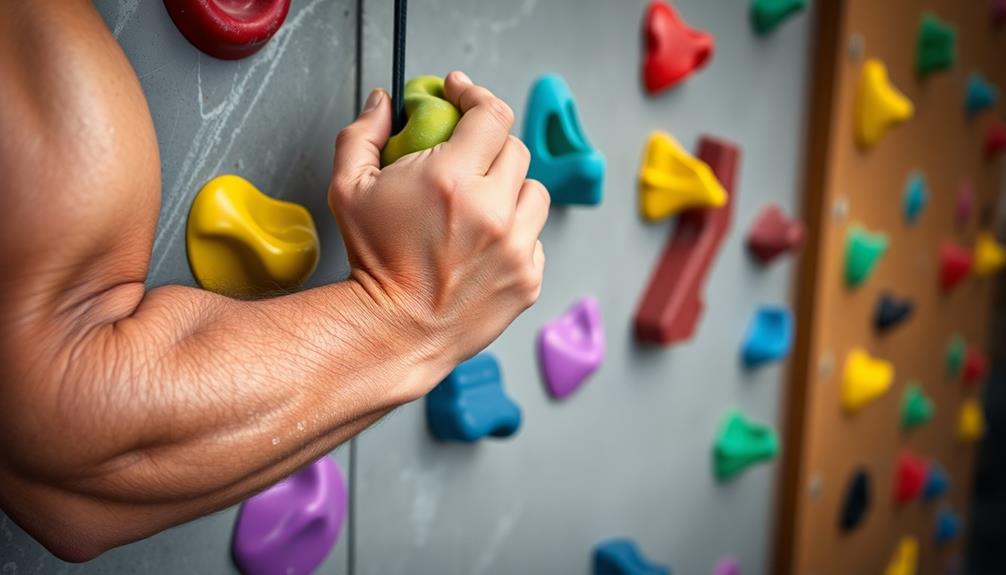Bouldering builds muscle through full-body engagement and dynamic movements. You'll develop upper body strength in your forearms, biceps, triceps, shoulders, and back as you climb. Your core muscles, including abs and obliques, stay constantly activated for stability. Lower body power comes from using your legs to push and balance. Grip strength improves notably due to various hand positions and holds. The sport also enhances flexibility, balance, and stabilizer muscles. As you progress to more challenging problems, you'll experience increased muscular endurance and stamina. With proper nutrition and recovery, your muscles will grow and adapt to the demands of bouldering. Let's explore these muscle-building benefits in more detail.
Core Insight
- Bouldering engages multiple muscle groups simultaneously, providing a full-body workout that builds strength and endurance.
- The constant core activation during climbing movements strengthens abs, obliques, and lower back muscles.
- Upper body muscles, including forearms, biceps, and shoulders, are intensively worked through various climbing holds and movements.
- Lower body power is developed through leg pushes, precise foot placements, and dynamic movements like jumps and leaps.
- Grip strength is significantly enhanced due to the constant challenging of forearms and fingers on different hold types.
Core Engagement in Bouldering

Bouldering is a great way to engage your core muscles. As you climb, your abs, obliques, and lower back work together to keep you balanced and stable on the wall. This constant activation helps strengthen your core over time. Bouldering also improves flexibility and mobility while targeting specific muscle groups. The constant tension and movement in climbing help improve overall muscle performance.
When reaching for holds, you need to keep your body close to the wall, which requires a tight core. Overhanging routes are especially challenging for your midsection, as you'll often find yourself in horizontal positions, fighting gravity.
Dynamic movements, like powerful jumps between holds, also rely heavily on core strength. You use your abs to generate momentum and control your body in mid-air.
Even when resting on the wall, you engage your core to maintain your position. This constant tension throughout your climbing session contributes significantly to muscle development in your midsection.
Upper Body Strength Development
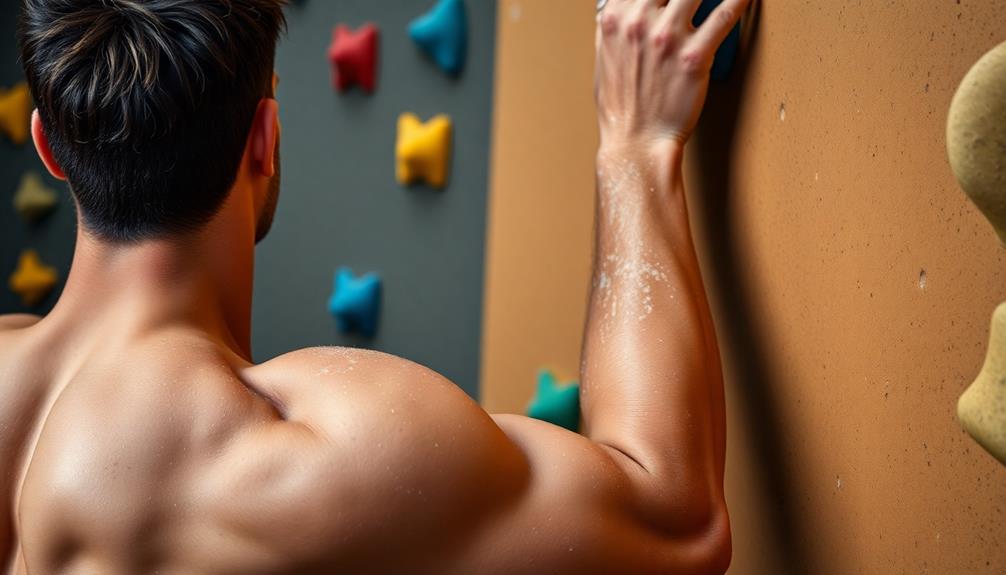
Bouldering is a great way to build upper body strength. As you climb, your arms, shoulders, and back muscles work hard to lift and hold your body. Exercises like pull-ups and lock-offs make these muscles stronger.
Bouldering works specific muscles:
- Forearms and grip: Holding small ledges strengthens your grip
- Biceps and triceps: Pulling up and pushing away from the wall builds arm muscles
- Shoulders: Reaching for holds engages shoulder muscles
- Back: Pulling motions and core stability develop back strength
Different types of boulder problems give you a full upper body workout. You'll build balanced strength and coordination. Over time, regular bouldering will visibly increase your upper body strength and muscle tone.
Lower Body Power Gains
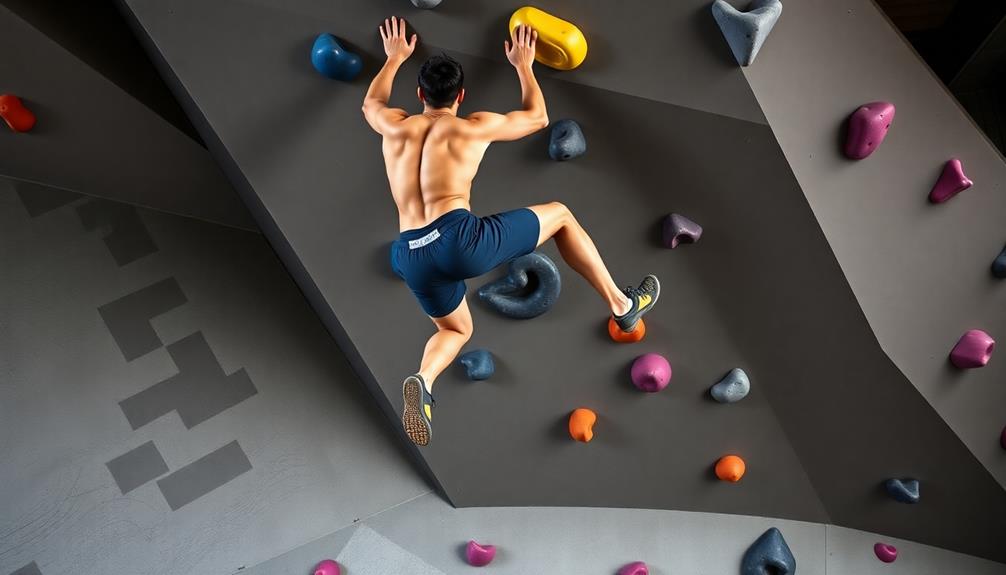
Bouldering is great for building strength in your legs, glutes, and core. As you climb, you use these muscles in different ways. This helps you develop power and endurance. Your quads and calves work hard to push you up the wall. Your hamstrings and glutes keep you stable and strong when making dynamic moves.
Bouldering helps your lower body in several ways:
| Muscle Group | Benefits |
|---|---|
| Quadriceps | Explosive power |
| Hamstrings | Flexibility and control |
| Calves | Endurance and balance |
| Glutes | Strength and stability |
| Core | Overall body control |
As you keep bouldering, you'll notice your lower body getting stronger. Your legs will have more power for pushing moves. Your core will improve, helping you stay balanced during tricky sequences. Regular bouldering sessions will boost your overall lower body power. This will help you perform better both on and off the wall.
Grip Strength Enhancement
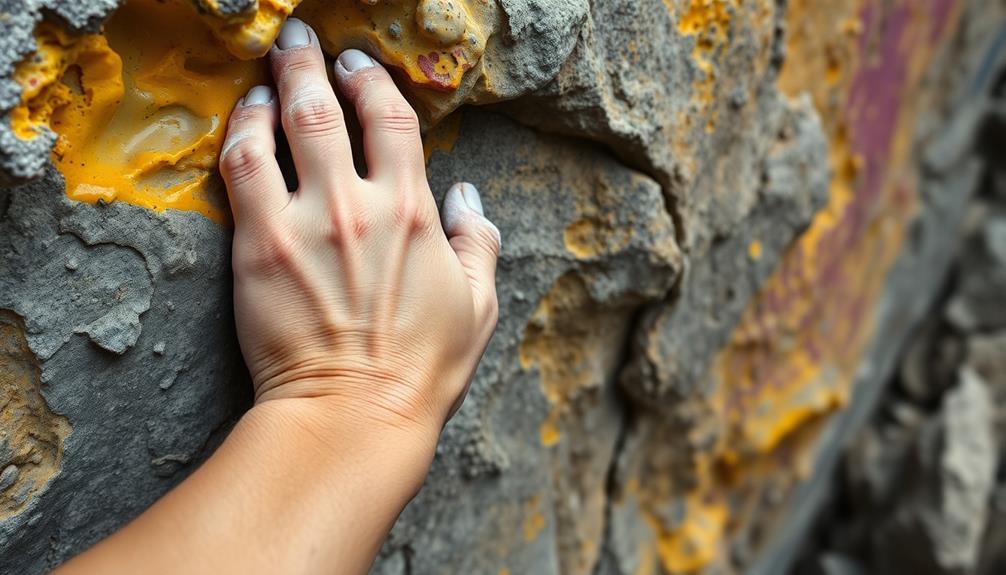
Bouldering is one of the best ways to make your grip stronger. As you climb, you'll use different hand positions and grips. This challenges your forearms and fingers. You'll come across crimps, slopers, pockets, and pinches. Each one requires using your muscles differently. Wearing compression sleeves on your forearms can help your muscles recover. They might also help you perform better during bouldering sessions.
The more you go bouldering, the longer you'll be able to grip and the more power you'll have. You'll be able to hold onto small holds for longer. You'll also have more control on bigger, smoother surfaces. Better grip strength helps with more than just climbing. It's useful for daily activities and other sports too.
To get the most grip strength gains, work on problems that focus on specific grips. Use a hangboard to train your finger strength. Make sure to balance your training with rest. This prevents injuries from overuse. It also helps you keep making progress with your grip strength.
Dynamic Movement and Muscle Activation
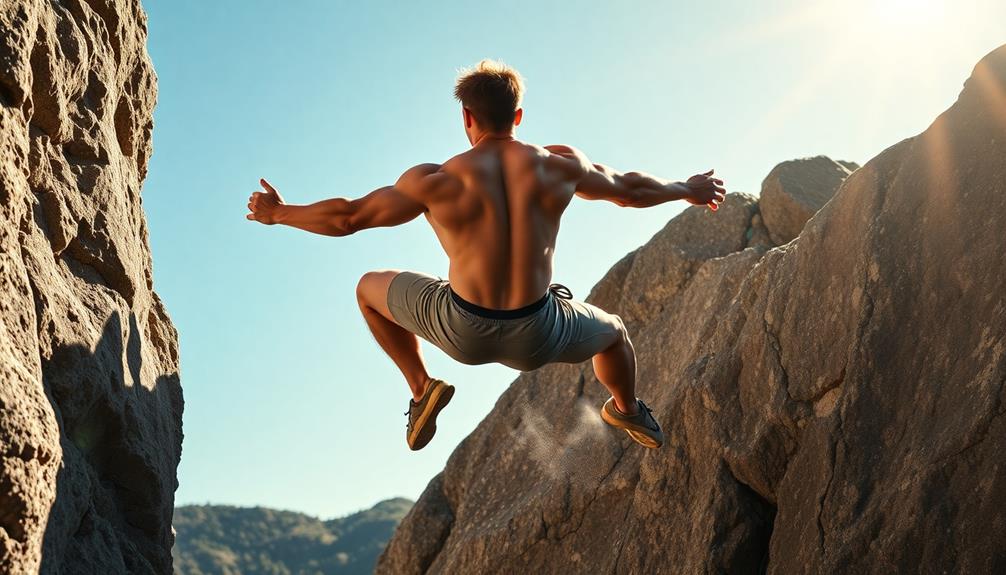
Bouldering is more than just grip strength. It's a full-body workout that activates many different muscles as you move. When you climb, your core, legs, and upper body all work together. This helps you build overall strength and muscle. Climbing hard can make your muscles sore. Using cooling gel packs can help relieve soreness and speed up recovery.
Bouldering includes dynamic movements like:
- Powerful jumps and leaps
- Quick direction changes and body rotations
- Precise foot placements and balance shifts
These movements need explosive power, agility, and coordination. Your leg muscles, like your quads, hamstrings, and calves, work hard to push you up and keep you balanced. Your back muscles, like your lats and rhomboids, stabilize your body and pull you up the wall. Your core is always working to keep your body tense and control your movements while climbing.
Endurance and Muscular Stamina
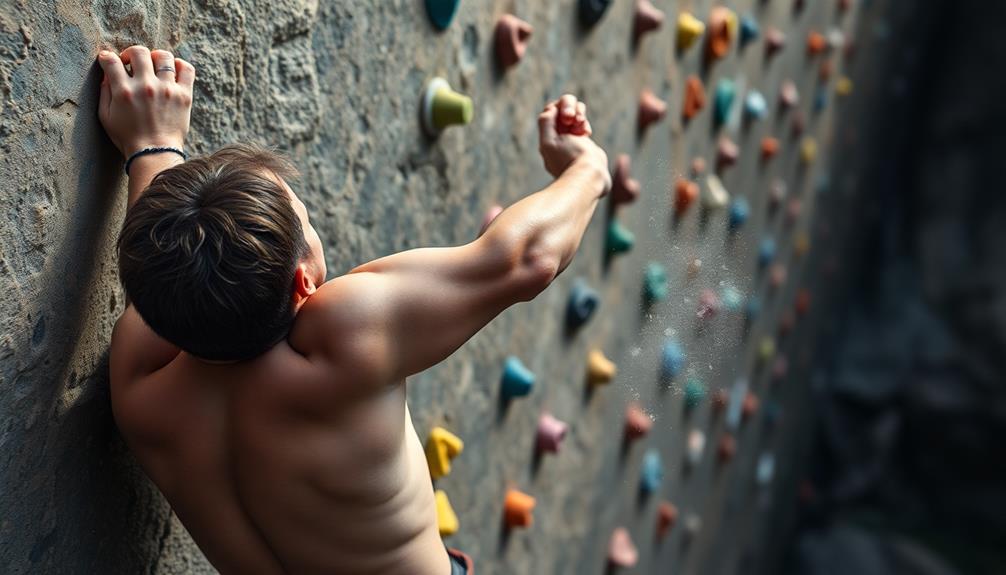
Stamina is key for success in bouldering. As you climb, your muscles are constantly working to keep you on the wall. Over time, this prolonged effort builds endurance and muscular stamina. You'll notice improvements in your ability to climb longer and tackle harder routes. Some climbers take herbal supplements with turmeric and ginger to help with muscle recovery and reduce inflammation.
Bouldering makes your muscles work in isometric contractions, holding positions for long periods. This type of exercise is great for building muscular endurance. The repetitive movements of bouldering, like pulling, pushing, and gripping, also help condition your muscles for sustained activity.
As you get better, you'll be able to climb for longer without getting tired. This increased stamina will also improve your overall fitness and help with daily activities that need sustained muscular effort.
Balance and Stabilizer Muscles
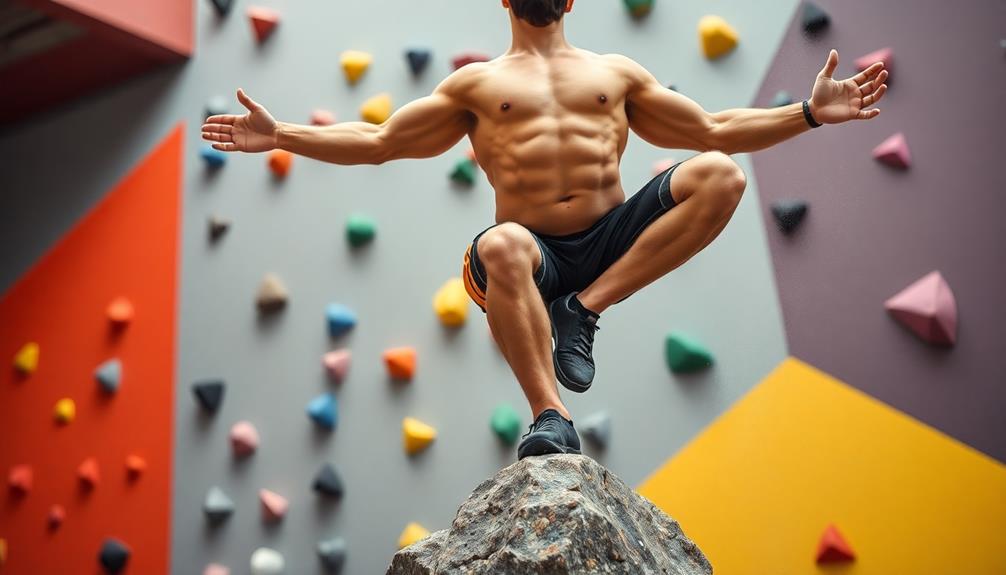
Bouldering is a great way to work out your balance and stabilizer muscles. As you climb, you'll use muscles you didn't even know you had. These muscles keep you stable on the wall and help prevent falls. Bouldering is like a full-body workout that targets many muscle groups at the same time.
Here are three ways bouldering improves your balance and stability:
- It engages your core. Your abs, obliques, and lower back work together to keep you in position.
- It develops your body awareness. You'll get a better sense of where your body is in space, which improves coordination.
- It strengthens your ankles and feet. Making precise foot placements on small holds will strengthen these often-neglected areas.
Flexibility and Range of Motion

Bouldering is a great way to improve your flexibility and range of motion. As you climb, you'll reach for holds and twist your body into different positions. This helps you become more flexible all over, from your arms and legs to your core, back, and fingers. It's like stretching and massaging your muscles at the same time.
The more you boulder, the easier it becomes to do moves that seemed impossible before. You'll be able to do high steps, heel hooks, and drop knees with practice. Being more flexible is good for your climbing and your daily life.
Bouldering also works your joints in different ways. This helps prevent injuries and improves your overall physical health. It's a fantastic full-body workout that makes you more flexible and mobile.
Recovery and Muscle Growth
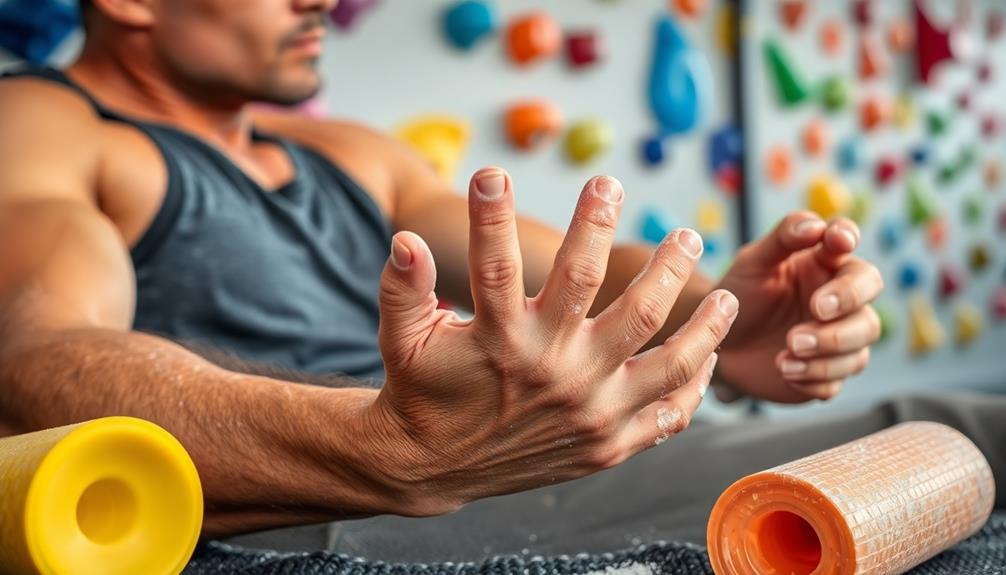
Bouldering pushes your muscles to the max, causing tiny tears in the fibers. After climbing, your body fixes these tears, making your muscles stronger and bigger. To get the most out of this, you need to focus on recovering right. Getting good sleep is key for helping your muscles bounce back. Try using calming scents to make your bedroom more relaxing for better rest.
Three important things for recovery and muscle growth:
- Rest: Give your body enough time between sessions to repair.
- Nutrition: Eat foods high in protein to help build muscle.
- Hydration: Drink lots of water to keep your muscles working well.
Frequently Asked Questions
How Does Bouldering Compare to Weightlifting for Muscle Building?
You'll find bouldering builds more functional strength and endurance, while weightlifting targets specific muscle groups. Bouldering engages your whole body dynamically, but weightlifting allows for more precise control over muscle development and progression.
Can Bouldering Alone Provide Sufficient Muscle Growth for Beginners?
Yes, you'll see muscle growth as a beginner with bouldering alone. It's an effective full-body workout that engages various muscle groups. However, you may eventually need to supplement with other exercises for more targeted muscle development.
What's the Ideal Bouldering Frequency for Optimal Muscle Development?
For best muscle development, you'll want to boulder 2-3 times a week. This frequency allows your body to recover between sessions while still providing enough stimulus for growth. Don't forget to incorporate rest days and proper nutrition.
Are There Specific Bouldering Techniques That Target Particular Muscle Groups?
Yes, there are specific techniques that target different muscles. You'll engage your arms and back with overhangs, work your legs on slab climbs, and challenge your core with dynamic moves. Pinches strengthen your forearms and fingers.
How Long Does It Typically Take to See Muscle Gains From Bouldering?
You'll typically notice muscle gains from bouldering within 4-8 weeks of consistent practice. However, results vary based on your starting fitness level, frequency of sessions, diet, and rest. You'll see changes faster with proper nutrition and recovery.

